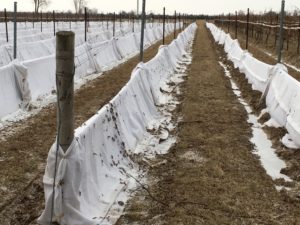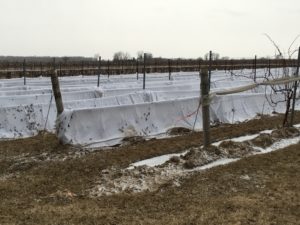As pretty much the whole province has experienced spurts of on-again/off-again arctic cold, it’s only natural to wonder (even worry) about what these extreme temperatures must be doing to the vines.
After the last polar vortex winter a few years ago, I couldn’t help notice how many wineries have purchased wind machines. And who can blame them, when a fraction of a degree more warmth in the air swirling around the vines on a cold night can make the difference between a healthy yield and an increase in the amount of bunches that end up as verjus.
On the recent family day weekend, I visited the EPIC wine region (Essex, Pelee Island, Coast) on the shores of Lake Erie. Though the region is further south than other regions in Ontario, it’s not immune to extreme weather. Indeed, wineries in the area no doubt vividly remember 2014 when they lost most of their crop due to cold winter temperatures.

A few weeks before my visit, I was in touch with Ann Wilson of Oxley Estate Winery. I asked her whether they were concerned about this winter’s extremes. She basically said that they manage what they can manage, but they won’t know till spring what the impact really is. But then she added a comment that intrigued me. She said it’ll be interesting to see whether their experiment in “blanketing” their Merlot and Syrah pays off.
I didn’t get a chance to ask what that meant, but as I headed to the region, I kept my eyes out to see if I could figure out what she was talking about. As I neared Oxley on County Road 50, I saw white, pup-tent like coverings on various rows of vines on the corner of one of their properties. Clearly this was what she was talking about. After stopping to snap a few pictures, I found Ann and Murray and asked them about it.

They said they heard that some wineries in Prince Edward County (PEC) and Quebec have used these blankets (geotextiles) as a way of protecting the vines and that the wineries have had success with them. So, last year Murray and Ann visited PEC to learn more about it.
They decided to give it a try this winter. According to Murray, the idea behind the blankets is to create kind of a greenhouse effect atop the vines. When the geotextile gets wet, it freezes and then the warmth of the sun and the heat from the ground stay trapped beneath the blanket.
While it sounds simple, actually placing the blankets on is quite labour intensive, he said. For one thing, they have to prune in the fall, rather than in the late winter/early spring. They also have to lower the trellis wire and tie the canes to the lower wire. Then they have to find a way to deal with the metal poles that run the length of the row to hold up the trellis system. One of the blanket edges has a wire on it that helps keep it down, but the other edge they weight down with dirt.
Since this system is not widely used, the timing of when they’ll remove the blanket is another matter. The fact that there aren’t many wineries using this system means there’s limited experience to draw on. And, since the growing season starts sooner in the EPIC region than in PEC, it’s a decision Oxley will have to make on its own.
 I think many local growers will be paying close attention to how this trial works at Oxley. One thing’s for sure, they couldn’t have picked a better winter to test this technique. If it’s successful and proves worth the added time and expense, growers will have another tool to help manage the impact of climate change.
I think many local growers will be paying close attention to how this trial works at Oxley. One thing’s for sure, they couldn’t have picked a better winter to test this technique. If it’s successful and proves worth the added time and expense, growers will have another tool to help manage the impact of climate change.